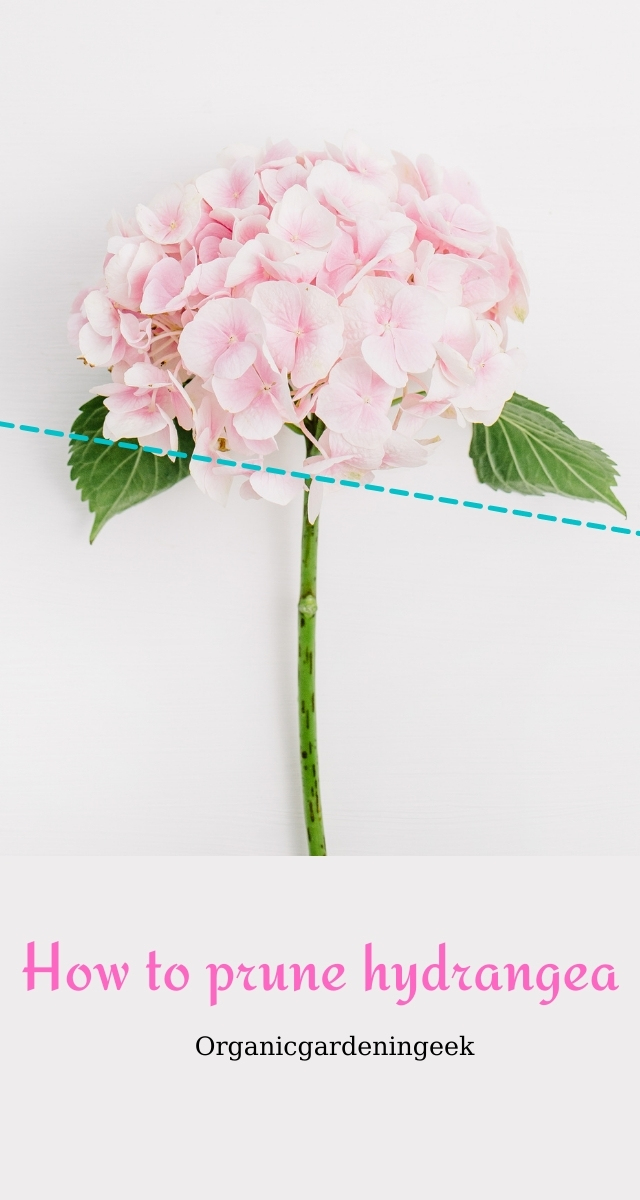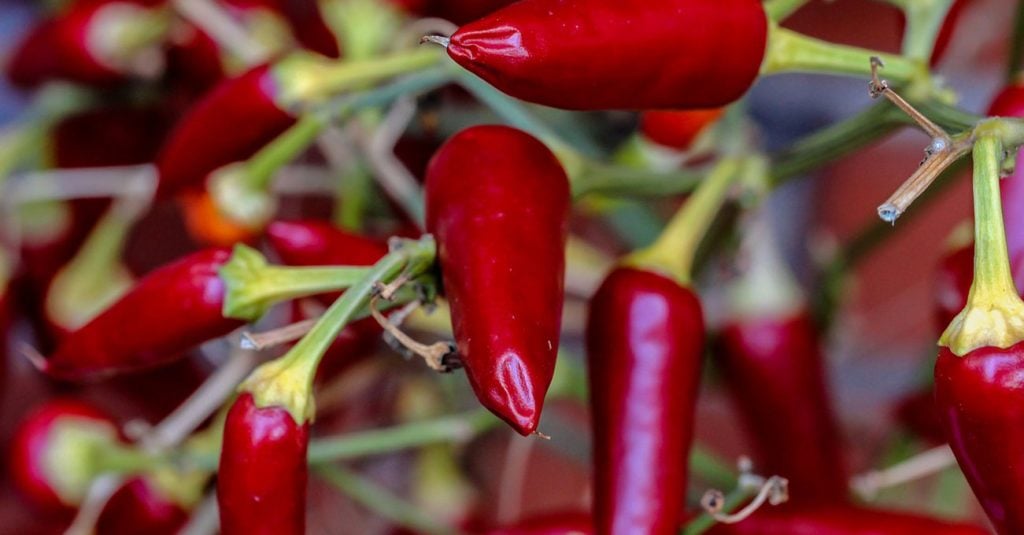Hydrangeas are available in a variety of forms and sizes. They can be either shrubs or climbing vines. So, pruning or deadheading hydrangeas and knowing which variety needs what sort of care is critical part of having healthy blooms every season.
Because the shrubs have a variety of heights, ranging from a few feet to 10 feet tall. The Pee Gee hydrangea may reach a height of up to twenty-five feet. If permitted, many climbing hydrangea plants may reach heights of eighty feet. Hydrangea blossoms come in a variety of colors, from white to red to blue.
The shrub hydrangea is the most common variety of hydrangeas. These bushes like full to partial light in hotter climes and need to be shaded from the afternoon heat. The majority of shrubs will only blossom on stems from the previous year. The flowers are arranged in clusters of a few smaller blossoms.
The majority of these plants are sensitive; however, others are hardy. The color of certain hydrangea plant blossoms varies depending on the soil’s pH level, which is fascinating to know. (Keep reading for more details)
What are Hydrangeas? – The plant characteristics
Hydrangeas are woody, flowering shrubs. They range in height from two feet to ten feet tall. Some hydrangeas are climbing plants, which can reach nearly eighty feet high. They are sometimes tender, but hardy varieties can survive in zones as cold as zone two.
Hydrangeas generally require a good deal of sunlight to grow. However, in the warmer regions of the south, the shrubs should be shaded from the hot afternoon sun, as this can damage the plant. Hydrangeas should be cut back to the ground in late autumn in colder climates.
This is because if the plant freezes back to the ground, it may not bloom.
Most of the hydrangeas will only flower on old wood and should be pruned down or deadheaded to half of the new growth to encourage more flowers. The exception to this is the endless summer hydrangea, which will bloom on both old wood and new growth. The endless summer hydrangea is also the only hydrangea with repeat blooms, giving a garden blooming color all season long.
Hydrangeas make an excellent addition to any garden. They can be used as an accent or focal point. Some of the lower growing hydrangeas also make perfect border plants. Growing in various regions and soil climates, a hydrangea plant can be worked into any garden or growing condition.
What are the popular Hydrangea varieties?
Here are the most demanded 8 varieties of this plant. Keep reading to learn about how to grow, care and prune them.
1. Hydrangea quercifolia (Oak Leaf Hydrangea)
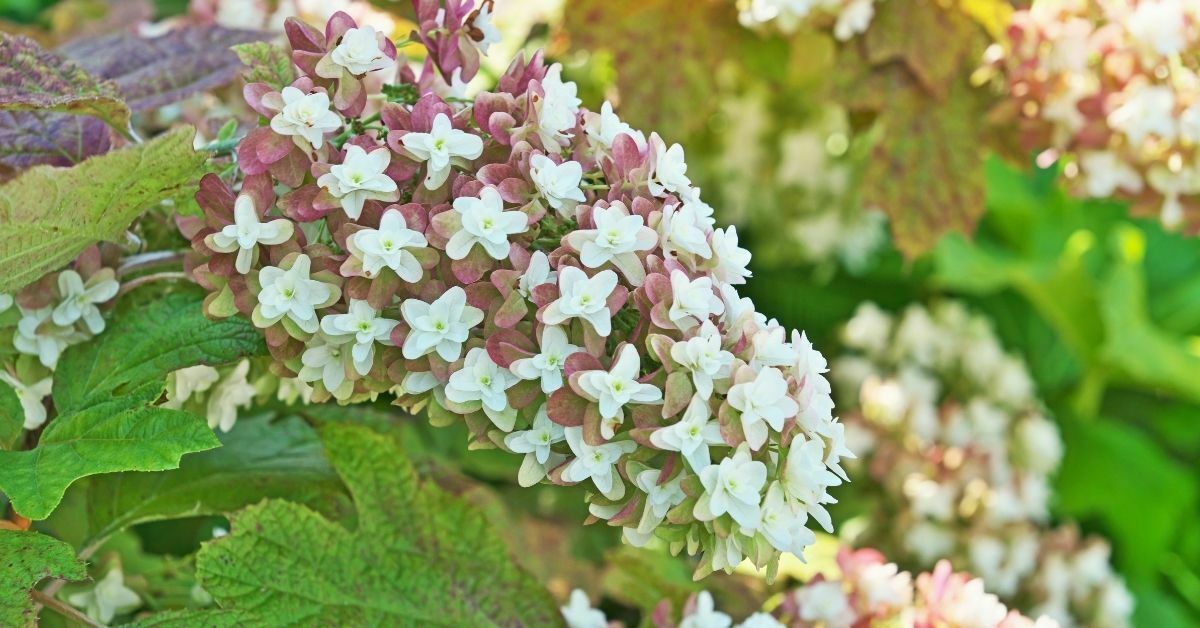
Hydrangea quercifolia, popularly known as oak leaf hydrangea, is a south-eastern American native. This blooming shrub possesses characteristics that make it appealing to look at at any time of year. Tender lettuce-green, oak-shaped leaves develop in the early spring.
The flower clusters develop later in the spring, and they are huge, creamy pyramids that can grow to be a foot long. The hydrangea quercifolia’s blossoms will change color over time, going from pale pink to rose to a lovely tan. The blossoms can also be found deep into the winter.
Its leaves may be seen far into December. During the fall months, the leaves turn to a rich purple and scarlet tint. When January arrives, its branches and peach-covered exfoliating bark add a lot of winter appeal that many gardens lack.
Hydrangea quercifolia loves part to full shade and may reach a height of six to eight feet. Division, cuttings, or seeds can propagate plants. For the plant to grow, the soil must be wet and well-drained. Hydrangea quercifolia is hardy in zones 5–9 and can be used as a specimen or massed for a focal point in a shrub border.
The hydrangea quercifolia is a disease and insect-resistant, as well as low-maintenance. Unlike most other hydrangea plants, which require a lot of water, It is drought resistant. Because buds are set in the early fall, pruning should be done just after flowering. It will bloom profusely even in the shadow.
2. Peegee Hydrangea

Peegee hydrangea is a fast-growing, old-fashioned shrub. It’s known for its massive display of blossoms that bloom late in the summer after most other shrubs have done blooming. If left unpruned, the peegee hydrangea can grow to a height of twenty-five feet or more. During the growth season, they appreciate full to partial shade and moderate watering.
A peegee hydrangea’s bloom season is particularly lengthy, commencing in mid-summer and extending until late October. During the bloom season, the color of a peegee hydrangea’s blossoms varies. The blossoms start off white, then change pink, then rusty brown in the autumn. Its blossoms do not vary with the pH level of the soil, unlike some other varieties.
Originally from Japan and eastern China, peegee hydrangea is an adaptable shrub that will thrive almost anywhere. Because the blooms are only produced on fresh growth, pruning may be done in late winter. It is hardy in zones three through eight. They are relatively easy to start from cuttings. Most of the flowers on the peegee hydrangea are sterile and will not produce seeds.
Peegee hydrangea works best when placed in the borders of a landscape or in mixed shrub borders where its coarse texture will not stand out. Many gardeners prune it to tree form, as they think it is more attractive this way. Properly pruned, a peegee hydrangea will be equally striking in tree or shrub form.
3. Blue Hydrangea
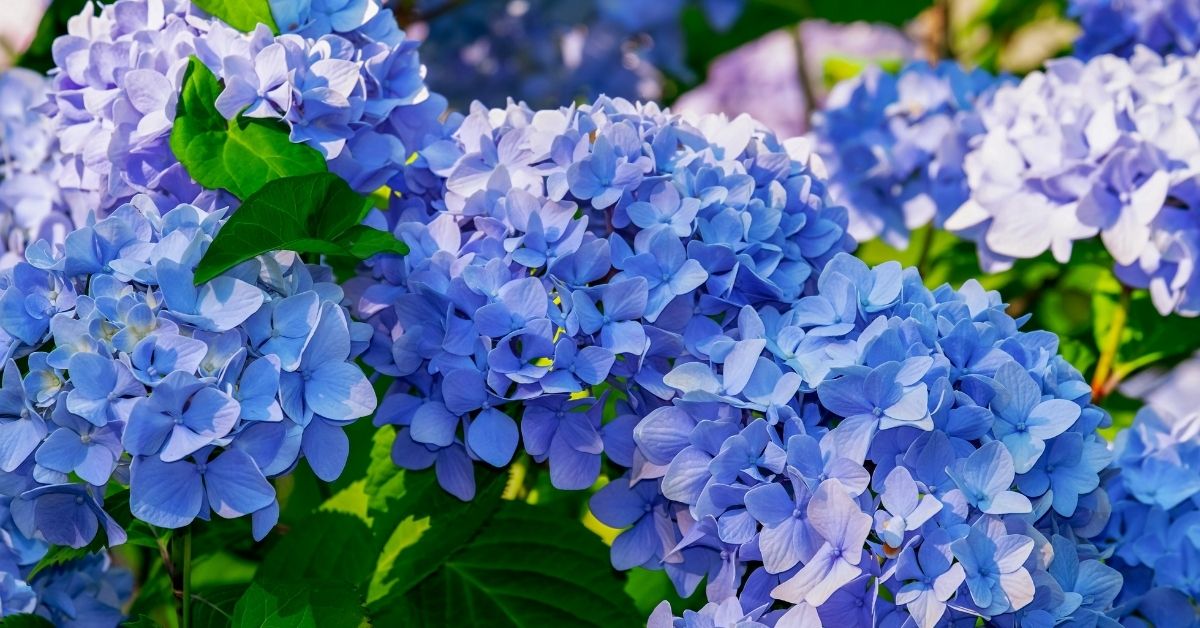
One of the most often sought-after hydrangea colors is the blue hydrangea. The lovely blue flower bunches look spectacular against the deep green foliage. They are easy to grow and can be implemented into nearly any garden setting. There are several different types of blue hydrangeas and some that can even be custom tinted to match the rest of a garden.
One of the most famous of them is the Nikko Blue hydrangea. The Nikko Blue hydrangea has blooms that begin as cream-colored with blue margins and then turn a solid blue as the plant matures. The Nikko Blue hydrangea prefers full shade to partial sun and is widely adaptable to a range of soils. Hardy in zones five through nine, the Nikko Blue hydrangea prefers slightly acidic soil.
Another of the blue flowering type is the Blue Billow. This blue variety is one of the earliest blooming lacecap hydrangeas. They grow to four feet high and six feet wide and have many dark iridescent blue flowers. The plants prefer part shade and bloom early in the growing season. They are pretty cold-hardy and grow best in zones five through nine.
Another way to get blue hydrangeas is to custom tint the blooms personally. Affecting the acidity level of the soil will do this. Hydrangea microphylla will bloom either blue or pink, depending on the soil. In more acidic soil, the blooms will be blue and pink in alkaline soil. If flowers are pink and a blue would be preferred, simply add some aluminum sulfate to the soil mixture, and the following year blooms will be blue.
4. Nikko Blue Hydrangea
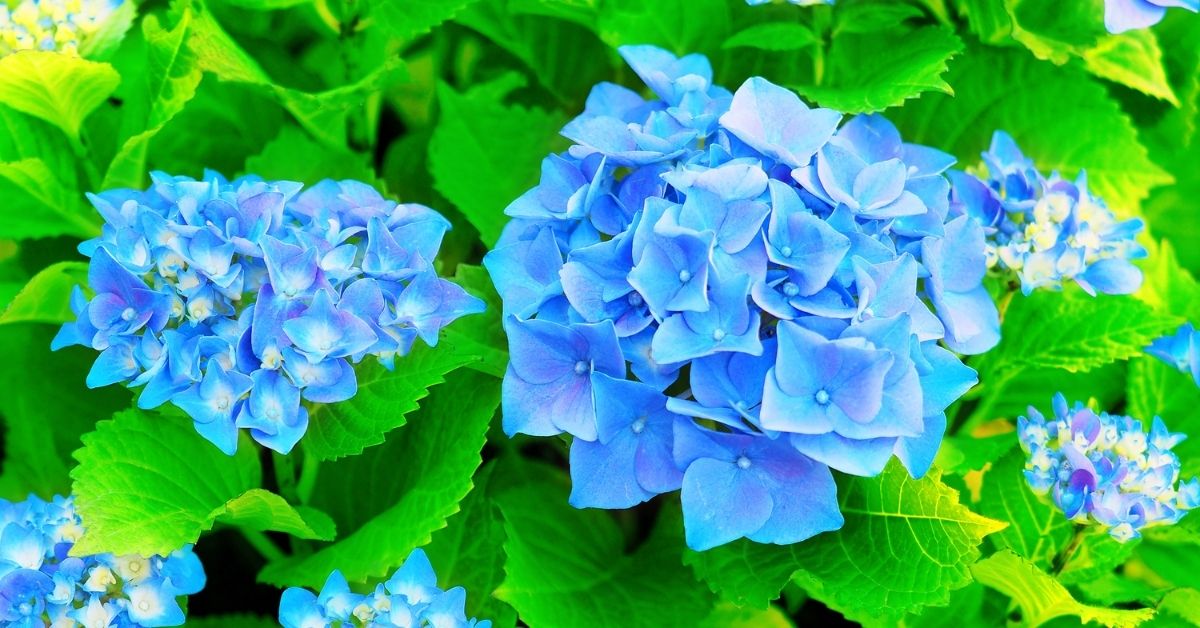
Nikko Blue hydrangea is the most common variety of family. The flower heads of the Nikko Blue hydrangea are enormous, spherical, and bright blue. Late in the spring, the blooms bloom above a circular canopy of lush foliage. The leaves of it are big, oval-shaped, and typically taper to a point.
The acidity of the soil determines the color of the Nikko Blue hydrangea’s flowers. It has rich blue blossoms in acidic soil, whereas the blooms in alkaline soil are lighter and occasionally even pink.
Hydrangea Nikko Blue thrives in rich, well-drained soils. They are not drought resistant and should be watered on a regular basis during seasons of drought. It enjoys full sun; however, it should be given partial shade in locations with excessively hot summers. Nikko Blue hydrangea bushes reach a mature height of four to six feet and a spread of five to seven feet.
These varieties are hardy in zones 5–9. They boast glossy bright green foliage and gorgeous blossom hues. They work well as an accent plant or can be placed in a border. The Nikko Blue hydrangea blooms on huge buds established by the previous season’s development. As a result, any pruning should be done right after flowering.
5. Climbing Hydrangea
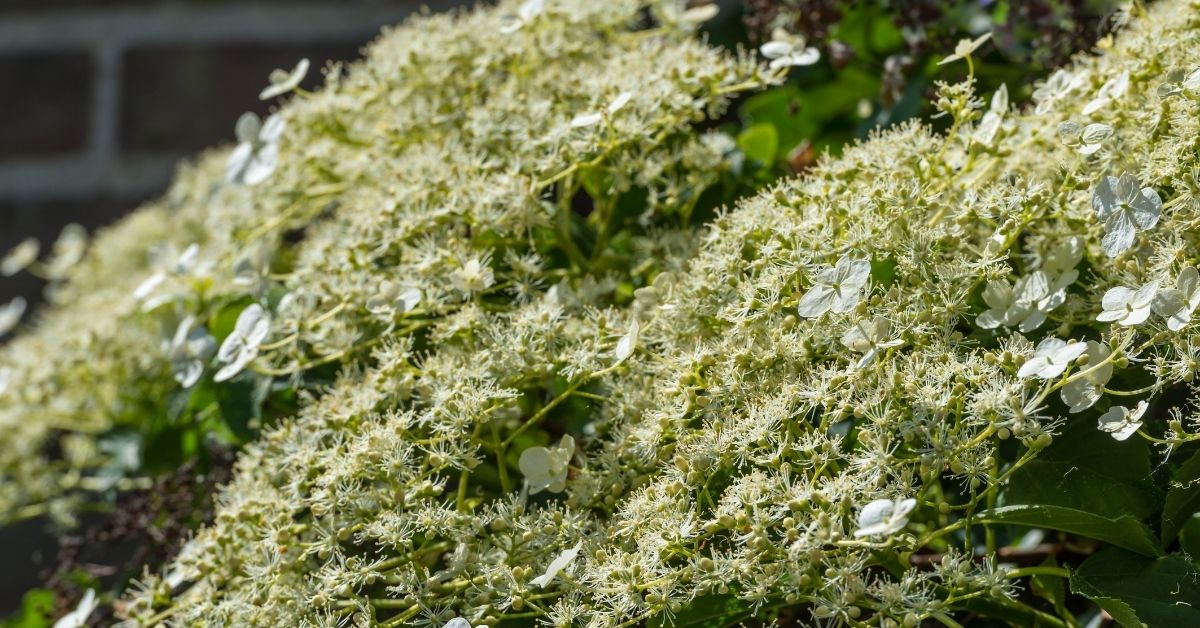
The climbing hydrangea is a beautiful, non-aggressive vine. It has large bunches of elegant white flowers and glossy, heart-shaped leaves that are very attractive. A climbing hydrangea prefers full sun to partial shade and is hardy in zones four through seven. It is adaptable to a wide range of soils but thrives best in moist, well-drained areas.
Adhering by root-like tendrils called holdfasts, it can grow to reach heights of up to eighty feet.
Climbing hydrangea is most often sold as a container-grown plant. Planting of the climbing hydrangea can take place from spring until fall. The depth of the planting should be equal to the depth it was planted at previously.
Adding organic matter will improve growth. Mulching the surface will aid in retaining moisture. Patience is important, as it generally takes a few years to adapt to the new environment.
Climbing hydrangea is native to the woodlands of China and Japan. The showy blooms will be six to ten inches in diameter and appear in late June or early July. The colors are actually made up of several small, fertile flowers bordered by larger sterile flowers. The climbing hydrangea is an attractive plant even when not in bloom, with its heart-shaped leaves and cinnamon-colored stems.
Few plants make as bold of a statement as this species. Its sheer potential makes it a necessity for any garden. Though not as common as the shrub hydrangeas, climbing hydrangeas are equally striking and make just as strong as an impression when allowed to thrive.
6. Endless Summer Hydrangea
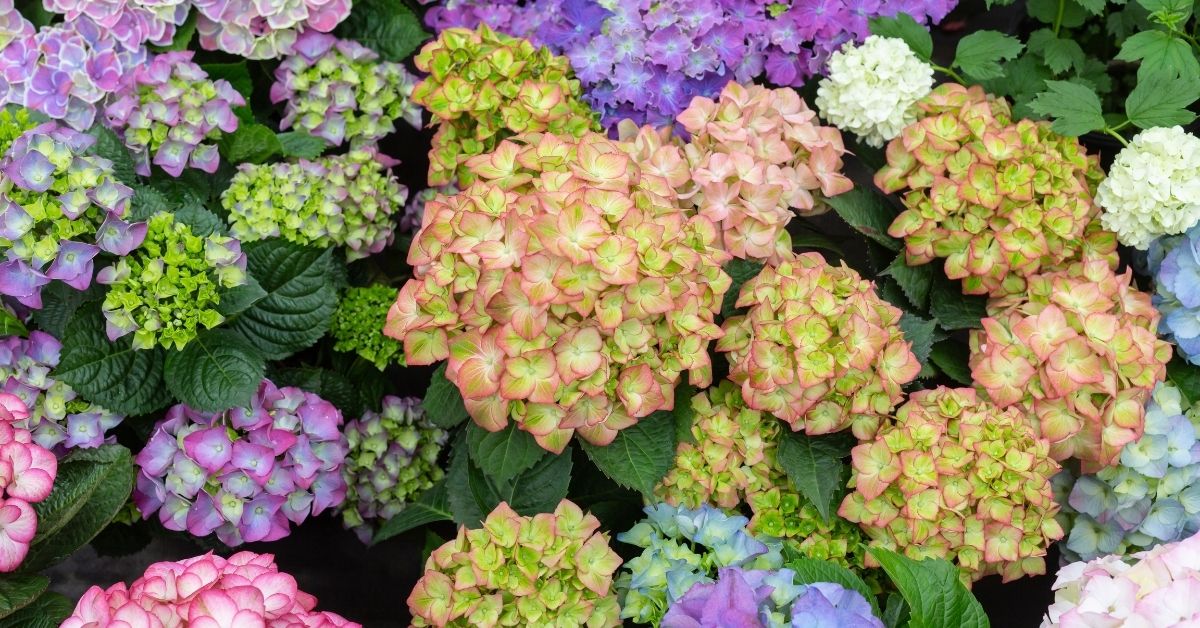
The endless summer hydrangea is one of the most popular and most exciting hydrangea hybrids. It is hardy to zones as cold as four and grows flowers in bunches up to eight inches in diameter.
Deadheading the plant will encourage blooms from April through October in warmer climates and June through frost in colder climates.
Discovered by Bailey Nurseries of St. Paul, Minnesota, one of the largest wholesale nurseries in the United States, endless summer hydrangea will reach three to five feet in height with a full, well-rounded shape. The endless summer hydrangea is an ideal shrub for mass plantings or as a specimen plant. It will take morning sun but thrive best in a shaded place in the garden. It prefers moist, well-drained soil.
The endless summer hydrangea requires a regular watering schedule to establish a deep, extensive root system during the first growing season. The foliage of the plant is medium to deep green and mildew resistant. Removal of old blooms will result in a repeat bloom, resulting in continual blooms from mid-spring until the first frost.
One of the most impressive features of the endless summer hydrangea is that it is so hardy. A member of the hydrangea macrophylla family, it is the only one that can withstand such cold temperatures. The endless summer variety is the most versatile hydrangea and also the most desired.
7. Hydrangea Lilacina
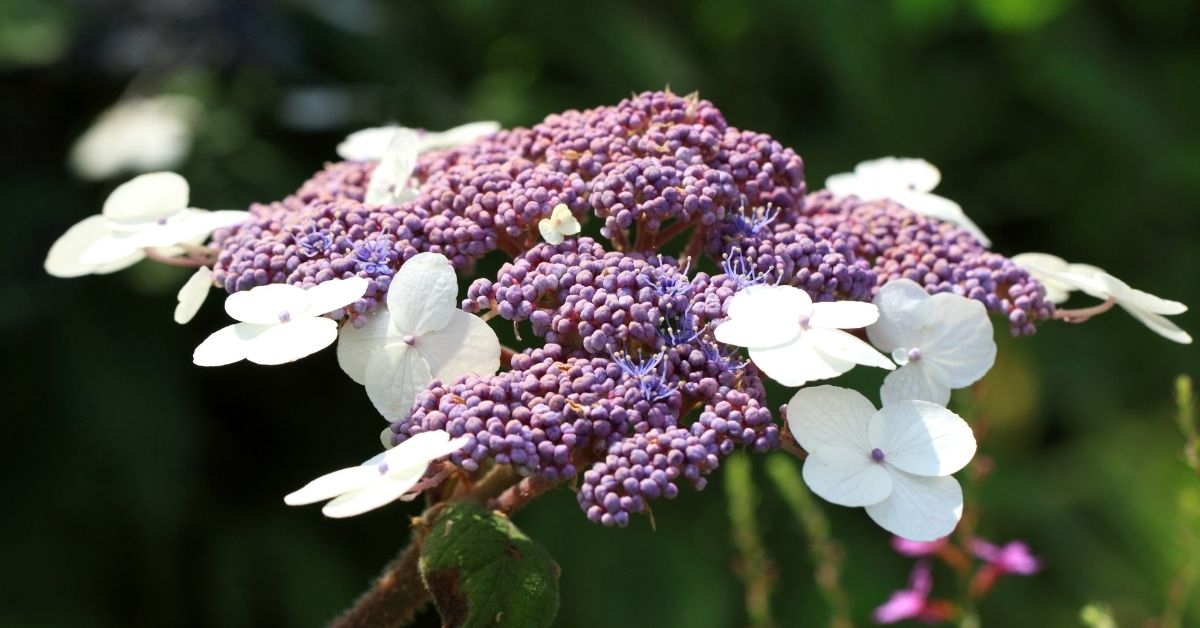
Hydrangea lilacina, also known as lace cap hydrangea, belongs to the microphylla hydrangea family. Large mauve sepals and a dark blue center distinguish It. During the summer, the flowers of the hydrangea lilacina last for an extended period. The mature height of this plant will be three to five feet tall.
Hydrangea lilacina, like most other varieties, has lovely green leaves. This deciduous shrub prefers acidic to slightly alkaline soil with good drainage. It is drought tolerant once established, but it requires a lot of water during the flowering season.
Hydrangea lilacina should only be pruned after the flowering season and only if absolutely required. Ensure the plant isn’t growing near a tree, which will take most of the nutrients that the plant requires to thrive. It prefers partial shade and is hardy in zones 5 through 9.
8. Hydrangea Macrophylla
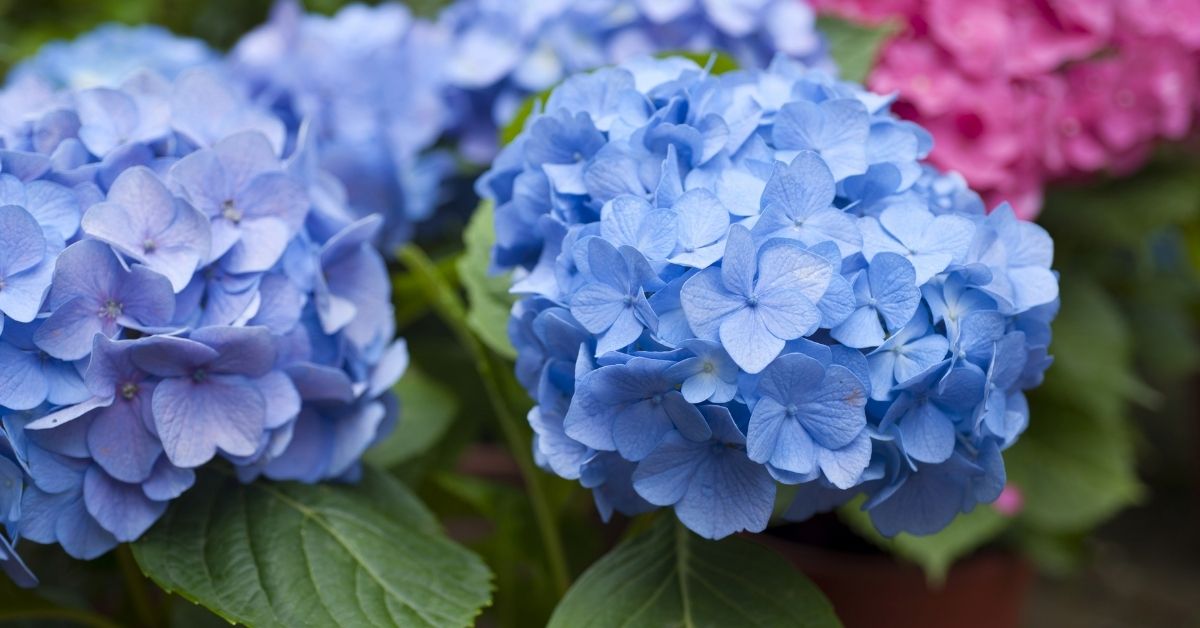
Hydrangea macrophylla is the most common class of hydrangea. It has large, round flower heads that range in color from white to deep red and blue. The flowers bloom in late spring over a rounded canopy of dense foliage. Hydrangea macrophylla also called bigleaf hydrangea, which has large, oval-shaped leaves that often taper to a point.
The flower color of the hydrangea macrophylla depends on the acidity level of the soil. It has blue flowers in acidic soil, while the blooms tend to be pinker in alkaline soil. In the transition range, many of the blooms are a muddy mauve.
Some cultivars of Hydrangea macrophylla color best in only one pH range, while others are effective in both. The most common of the blue flowering hydrangea macrophylla is the ‘Nikko Blue,’ which has deep blue flowers in acidic soil. The ‘Pink ‘n Pretty’ plant has bold pink blooms.
Fertile, well-drained soils are ideal for it. They are not drought resistant and should be watered on a regular basis during seasons of drought. This variety enjoys full sun; however, it should be given partial shade in locations with excessively hot summers. Hydrangea macrophylla bushes range in height from three to five feet.
Planting Hydrangea
Hydrangea planting may be a productive and enjoyable experience. All of the effort put into growing it will be rewarded once the gorgeous, brilliant bloom appears. The first stage in hydrangea planting is determining the ideal location for the most outstanding results.
Full sunlight, soil pH…
The chosen location must receive plenty of direct sunshine each day, although some shade is also desirable. To avoid root rot, the soil must be dry to wet and well-drained. The color of the flowers may be predicted by knowing the pH level of the soil.
The actual planting of hydrangeas is the second stage. The state the flower was obtained in determines when the planting should take place.
Planting time
Hydrangeas that have been cultivated in containers should be planted in the spring or fall. Early to mid-spring is the best time to grow bare root plant. The hole should be large enough to allow the roots to stretch out completely.
Once the roots have been spread, dirt should be applied a little bit at a time and pressed down firmly to remove any air pockets and provide proper support for the plant. The plant’s crown should be barely an inch or two below the soil’s surface.
Mulching
Planting hydrangeas is only the first half of the process. In locations where the temperature dips below zero degrees in the winter, mulch should be placed to the plant after planting to assist avoid frost heaving; mulching annually in the late autumn should help to protect the plant from being too cold in the winter.
The final stage in hydrangea planting is optional and only applies to specific species. This is for fine-tuning the hue of the bloom.
This is how to change the color of Hydrangeas
If you add some lime to the soil, the bloom will become pink for the next growing season. Adding aluminum sulfate to the soil will increase its alkaline content and give the flowers a blue color. Growing hydrangeas is a wonderful experience since the blooms are huge and beautiful.
How to Grow Hydrangeas
They are reasonably simple to grow. They don’t take much attention as long as the right circumstances are provided. Hydrangeas grow well in full to partial sun. To avoid root rot, they need good drainage, and they may grow in a variety of soil and water conditions. They are drought-hardy once established.
Hydrangeas may be grown in zones 5 through 9. While growing them, it’s essential to remember that they shouldn’t be trimmed too much in the winter because they’ll blossom on older wood stems.
Propagating
Hydrangeas are easiest to reproduce in a garden through division. Every few years or so, divide one big plant into numerous smaller plants to ensure that the plants have adequate area to flourish.
The capacity of some hydrangeas to alter bloom color dependent on the soil’s pH level is the most crucial factor to keep in mind when cultivating them. The bloom will be blue in more acidic soil, while in more alkaline soil, the flower will be a gorgeous pink. The blossoms will turn pink if you add lime and blue if you add aluminum sulfate.
Plant care
Hydrangea plant care is frequently prioritized during the summer months when the plant is in full bloom and then neglected during the winter months. This is unfortunate because mid-winter is a crucial period for its maintenance. Proper mid-winter hydrangea care will ensure a large, healthy plant with plenty of blooms for the following growing season.
Pruning is the first step in hydrangea plant maintenance. Any stems that bloomed the previous season should be trimmed back when trimming the plant in the winter. Unflowered stems should not be trimmed since they will yield blooms next year. This is also the time to cut back any dead stems or weak portions of the plant.
The capacity to vary the color of the flowers simply by adjusting the soil’s pH level is the most interesting aspect of hydrangea plant maintenance. If the blossoms are blue, adding some lime to diminish the soil’s acidity can turn the flowers pink. Aluminum sulfate can be used to make pink flowers blue. Hydrangeas require a lot of water and should be irrigated regularly during dry periods.
Why should you plant Hydrangenas?
Hydrangea flowers are gorgeous and often fragrant. Many people plant them in their garden for the lovely scent they give off during the blooming season. Others simply like their appearance. Whatever the reason and wherever the garden, they make a wondrous display.
The hydrangea flowers, themselves, are actually comprised of several smaller blooms bunched together. The smaller blooms in the center are the fertile blooms, while the larger flowers on the outside are sterile and used as protection for the more delicate ones.
Many of the hydrangea flowers are very delicate and not wind resistant. Because of this, any heavy exposure to wind will destroy the beautiful plants.
The flowers are also very popular in floral shops and as decorations. They dry out very quickly and make wonderful everlastings. The blooms are very common for use in arrangements, and the individual tiny blooms that make up the flower are often used as a garnish.
They can be used for just about any occasion. They look beautiful either in the garden, in the home, or on display. The scent of the flowers wafting through the air on a warm spring breeze will add a touch of romance to a deck or patio. On display in an arrangement of other dried or fresh flowers, the hydrangea is beautiful and large enough to take center stage.
The hydrangea lilacina is a huge and striking shrub with its magnificent blue flowers and erect form. Its flowers will develop on both old and young wood, making pruning a breeze. The stems contain a purple speckling that may be seen.
Pruning or Deadheading Hydrangeas
Deadheading hydrangeas is easy to do and will help in providing more blooms for the following growing season. Pruning them varies slightly from species to species, depending on when and where the plant will bloom. After the blooms have finished their season, removing them will allow the plant to focus its energy on storing food for the coming winter.
When the winter comes, it is essential not to cut off the brown stems. It is on these stems that the plant will bloom the following year. Pruning hydrangeas in the winter can entail topping off the plants to shape them. There should only be an inch or so taken off smaller plants and three to five inches taken off larger plants. The cut should be done just above a joint.
The following winter, these brown stems will become a whiter color and are ready to be removed. Pruning hydrangeas at this time involves removing these white stems so that new growth will be encouraged. Pulling gently on the white stems should remove them. If not, they may not be ready yet and will be in a few months.
How to Prune Hydrangeas Effectively

To understand how to trim Hydrangeas effectively, you must first understand the fundamental differences between the Hydrangea plants. Hydrangea pruning will vary depending on the variety of Hydrangea you’re looking at, and you may not need any at all.
Hydrangea pruning is explained in two ways, each of which is dependent on the Hydrangea plant’s family member. Lacecap Hydrangea pruning differs from Annabelle Hydrangea pruning in that both require separate steps. Hydrangea plants have essential traits that can be used to identify them. You may use them to figure out what kind of variety you have and what kind of trimming you should do to keep the plant healthy.
Method 1
The first type of pruning is for Oakleaf or Lacecap Hydrangeas. The Oakleaf Hydrangea has enormous oak leaves and white blossoms, making it simple to distinguish between the many Hydrangea species.
Lacecap Hydrangea is also known as Hydrangea blue or pink Hydrangea, and you can tell the difference by looking at the hue. Following the identification of the species, you may proceed to the first way of Hydrangea trimming.
This strategy requires you to prune or deadhead your plants well before August. The idea behind these Hydrangea plants is that they produce new flower buds on the older stems. Thus it’s critical to leave the older stems alone and not trim them.
Endless Summer Hydrangea pruning is the simplest of the bunch since this is one Hydrangea plant that will bloom regardless of the type of Hydrangea pruning you do.
Method 2
The following approach is designated for pruning Annabelle Hydrangeas, and the primary concept is that they bloom on fresh stems. As a result, you may easily prune your bushes regularly while still ensuring a beautiful bloom the following season.
Another topic is when to prune Hydrangeas, and the solution is to avoid the months of summer and early spring for Hydrangea pruning. Limelight Hydrangea pruning does not need to be done regularly. When it comes to ‘how to prune Hydrangeas,’ you should remove any unwanted stems that merely contribute to the clutter.
When to Prune Hydrangeas?
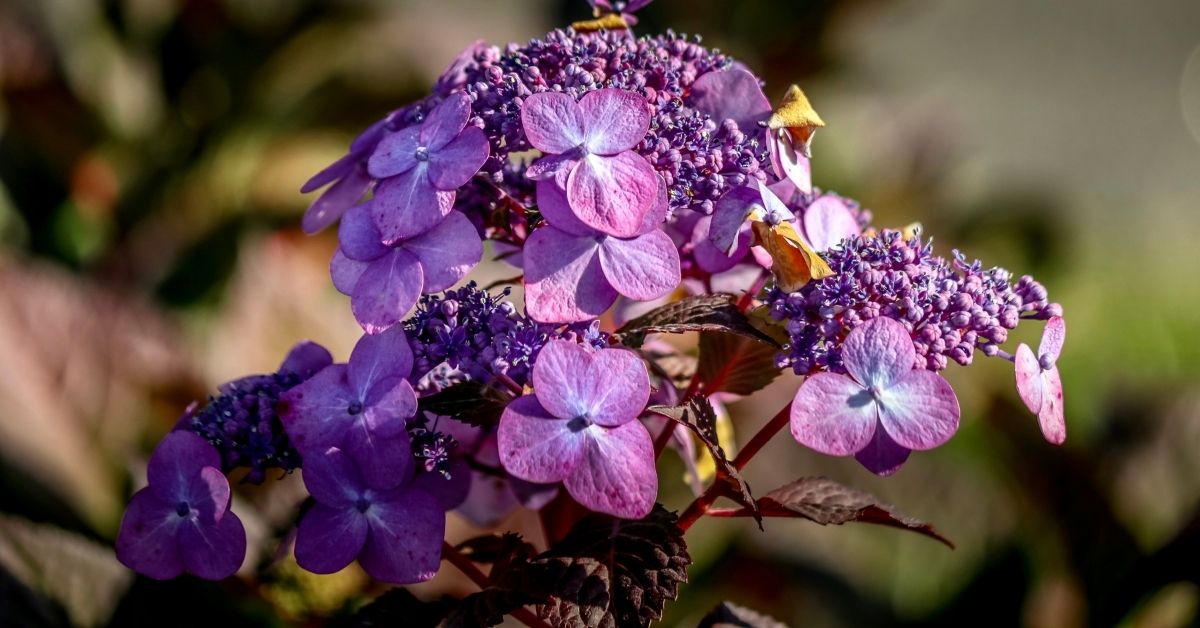
If you’re unsure when to prune or deadhead your Hydrangeas, double-check the sort of Hydrangea you have.
Varied Hydrangea plant species, on the other hand, have different times when they can be pruned. The period of the red Hydrangea differs from that of the Annabelle Hydrangeas, and you must correctly identify the species.
This is an easy operation since you have to assess them based on color and then start with the Hydrangea shrub pruning. When raising Hydrangeas, you often get to know the Hydrangea plant you’re working with.
The Macrophylla Hydrangea is unique in that it may be subjected to Hydrangea trimming without causing significant damage.
Pruning Hydrangeas: Precautions
While performing pruning on your plant, you must follow a few simple procedures. Make sure you know how to trim Hydrangeas properly and are familiar with the many varieties.
This Hydrangea species is noted for having a one-of-a-kind capacity to generate flowers. Endless Summer Hydrangeas get their name from the fact that they can bloom successfully in every climate. Furthermore, no amount of lousy pruning will stop them from growing, and they have been known to re-bloom after the older ones have been mistakenly destroyed due to Hydrangea pruning.
Endless Summer pruning is simple, and you won’t have to worry about a lack of bloom the following season. However, when trimming Endless Summer Hydrangeas, you should only be concerned with removing the dead stems and nothing else.
Endless Summer Hydrangea deadheading
You only need to remove the dead stems since Endless Summer will take care of itself. They are also known as Macrophyllas Hydrangea and are adapting well to the temperature and conditions in which they have been placed. In essence, there is only one way to prune Endless Summer Hydrangeas.
Hydrangea trimming should be completed well before August, as this is when the plant sets flower buds. Endless Summer Hydrangeas form their buds on old wood, which is why it’s best to avoid needless Hydrangea trimming after August.
Endless Summer Hydrangeas are a phenomenon
Endless Summer Hydrangeas have one-of-a-kind phenomena that make them a popular option for many settings. These bushes have thrived in harsh climatic circumstances, producing high-quality flowers season after season.
Furthermore, unlike other varieties, they are not impacted by poor Hydrangea pruning, making them impervious to the adverse effects of Hydrangea pruning. Even if unintentional Hydrangea pruning removes the bloom buds formed in August, the Endless Summer Hydrangeas can make up for the lost buds by growing new ones in the fall. This makes trimming Endless Summer Hydrangeas quite simple, risk-free, and painless.
